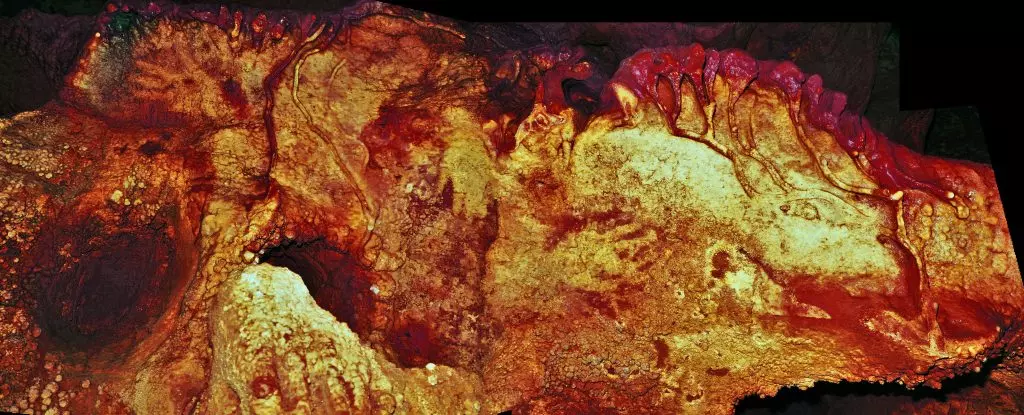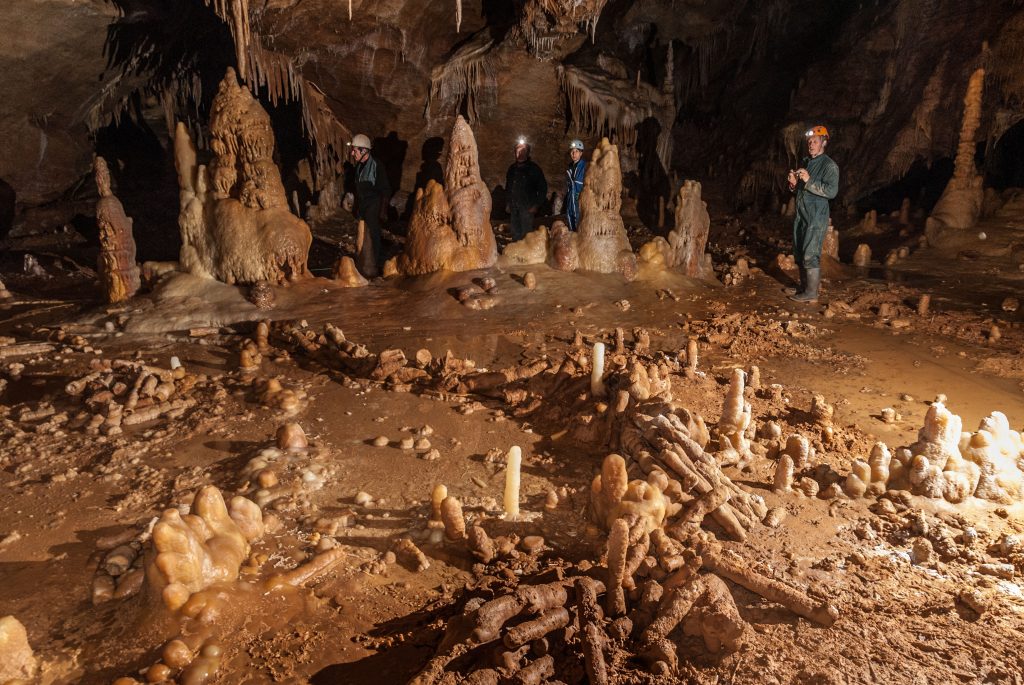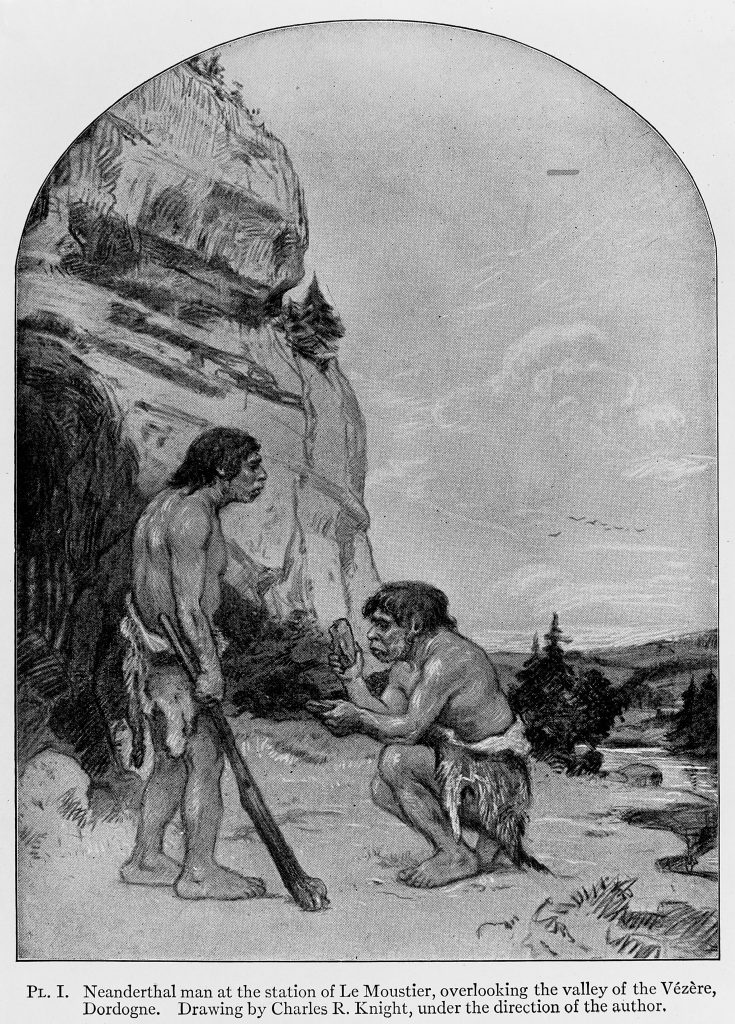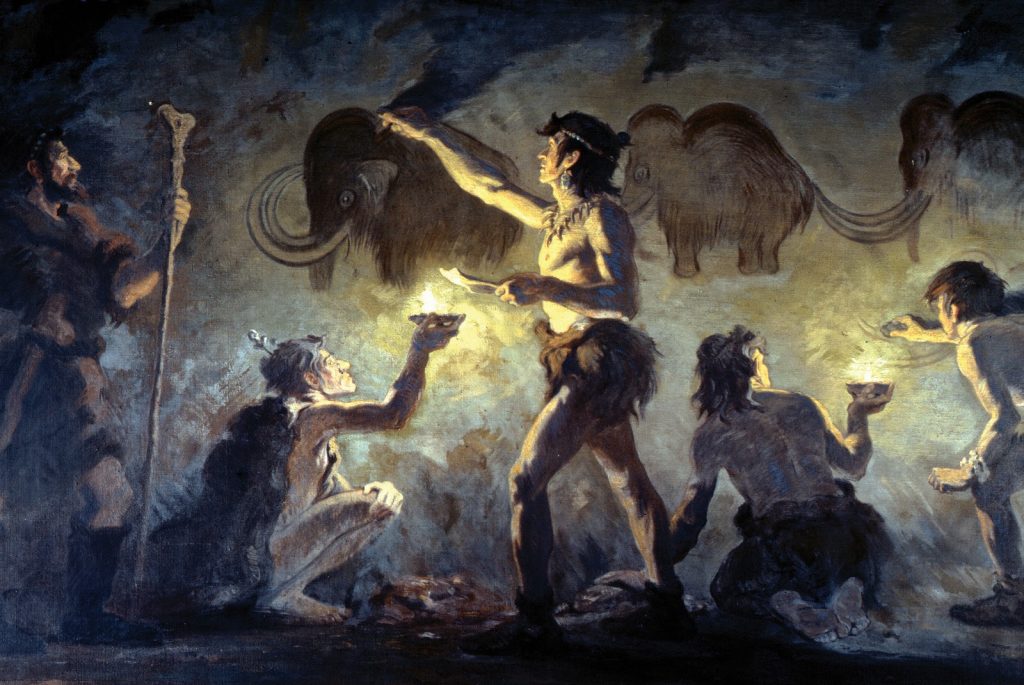Experts continue to debate whether Neanderthals were painters and jewelry-makers. A paleoanthropologist explores the evidence for Neanderthal art and the sources of people’s skepticism.

AS A NEANDERTHAL RESEARCHER, I’m familiar with the stereotypes of Homo neanderthalensis: dull, unintelligent, lacking the imagination to do more than bash each other on the head. They just sat around, gnawing on mammoth, awaiting their inevitable extinction. So, in 2018, I was excited when I saw a headline announcing “It’s Official: Neanderthals Created Art.” I quickly found the scientific article and read that new evidence from Spain had dated art in three caves at more than 65,000 years old. The only people in Europe at that time were Neanderthals!
Wait, I thought. It won’t be long before someone will question the date or suggest it was really modern humans who got there earlier and painted the caves. Sure enough, as soon as researchers said “Neanderthal art,” an NPR science news correspondent responded doubtfully, “If new evidence shows that humans actually arrived earlier than scientists now think, well, that’s the pattern of science.”
I wasn’t surprised. A year later, 44 researchers co-authored a paper critiquing the study from Spain, writing, “there is still no convincing archaeological evidence that Neanderthals created Iberian cave art.”
So, what is the evidence for Neanderthal art? And why are so many people skeptical that Neanderthals had the cognitive capability to make paintings, ornamentation, and other symbolic creations?
DID NEANDERTHALS MAKE CAVE PAINTINGS?
When most people think about Paleolithic art, they picture the 20,000-year-old paintings in Lascaux Cave or the 36,000-year-old paintings in Chauvet Cave, both located in France. These are generally associated with modern humans during the Upper Paleolithic—not Neanderthals, who lived around 400,000 to 40,000 years ago in Europe and parts of Asia. [1]
But, actually, dating cave paintings is notoriously difficult. They are generally made with mineral-based pigments that can’t be directly dated because they don’t contain organic matter. A few may contain organic material such as charcoal, which can be radiocarbon dated, but that only works for paintings younger than 50,000 years. For many cave paintings, researchers assume they are younger than 40,000 years or so, but they can’t establish a definite age.
That’s one of the exciting aspects of the aforementioned study in Spain. Archaeologists used uranium-thorium dating on tiny stalactites and stalagmites that formed over the top of the pigment.
These carbonate deposits, left behind when water and carbon dioxide move through rock, can provide a minimum age for the cave paintings beneath them.
The researchers used this method on three cave paintings: a red, ladder-like image at La Pasiega in northern Spain; hand stencils at Maltravieso in western Spain; and a curtain of stalagmites painted red at Ardales in southern Spain. All of them dated to approximately 65,000 years ago.
But the results have been challenged on methodological grounds (a dispute over the movement of uranium in groundwater in the caves) and by the conviction that only modern humans made art. Repeated claims and counter-claims mean it is unlikely that this controversy will be resolved any time soon. Still, there is evidence in other places that Neanderthals had the capacity for creativity.
DID NEANDERTHALS ENGRAVE BONES?
A promising recent find comes from the Neanderthal site of Einhornhöhle (Unicorn Cave) in northern Germany. In 2021, archaeologists announced the recovery of an engraved toe bone of Megaloceros giganteus, an extinct deer that could grow to about 7 feet tall, with an antler span of 12 feet! This toe bone is etched with six engravings that form five offset stacked chevrons. The angles formed by the intersecting lines are quite regular, ranging from 92.3 to 100.3 degrees. A second set of four short lines are incised on the proximal end.
These are not cut-marks related to butchery (deer toes are not terribly meaty) and were clearly made intentionally to form a pattern. In this case, the dates aren’t disputed. Radiocarbon dating at the site, and of the bone itself, suggest it is at least 51,000 years old.
Why would someone select the toe bone of a giant deer that is very rare in this area and engrave a series of chevrons onto it?
Clearly the pattern has no practical value. The authors suggest that the engraving, and possibly the choice of animal, must have symbolic meaning. And art is all about symbolism—representing an idea or object in some other form. For me, that speaks strongly to symbolic thought in Neanderthals.
But as you might expect, when something that looks symbolic is associated with Neanderthals, it doesn’t take long for people to give at least partial credit to modern humans. In this case, DNA was recently recovered from modern human fossils dating to more than 45,000 years ago at Zlatý Kůň, Czech Republic. The fossils contain long stretches of Neanderthal DNA, suggesting interbreeding occurred before 50,000 years. Some posit that the Neanderthals who exchanged genes with the ancestors of Zlatý Kůň also exchanged knowledge.
Here we go again. Neanderthals did something symbolic? Nah, they just copied modern humans. I think I’ve heard this story before.
DID NEANDERTHALS BUILD STONE CIRCLES?
How about Bruniquel Cave in southwestern France? This one is odd. More than 300 meters inside the cave lie multiple structures constructed from almost 400 stalagmite fragments (also called speleofacts). Two large circular structures, composed of up to four layers of stacked stalagmite fragments, stretch around 2 to 7 meters across and about 40 centimeters high. These are accompanied by several other accumulations of stalagmites. Based on reddening and blackening of some of the fragments, it appears that all of the structures are associated with fire.
Archaeologists dated the structures by looking at the age of broken stalagmites and when they began to regrow. The results consistently pointed to the structures being about 176,500 years old. At that time, the only ancestral human species in France were Neanderthals.
No light penetrates this part of the cave’s dark zone, so Neanderthals would have had to bring their own. Then, it seems, they collected and deliberately placed hundreds of speleofacts in circles and made fires that reddened and blackened many of them. According to the researchers, this demonstrates that Neanderthals were capable of complex spatial and social organization.

Why did the Neanderthals do this? Was it some sort of ritual? To be honest, we’ll never know. Is it art? That depends on what you consider art. One definition of art is that it is creative behavior with no practical purpose. By that definition, I’d say it fits.
For the most part, this find was fairly well-received. Some pointed out, however, that while Neanderthals made the structures, they did so while “leaving no trace of graphic activity.”
So, nice try, Neanderthals. But if you don’t paint the cave walls, does it really count as art?
DID NEANDERTHALS MAKE JEWELRY?
When it comes to jewelry—or personal adornment in archaeological terminology—there isn’t just a single example. At least 23 raptor talons, mostly from the formidable white-tailed eagle, have been found at 10 Neanderthal sites ranging in age from 130,000 to 42,000 years ago.
The talons are scratched with cut marks, indicating they were intentionally removed. Given the lack of meat on an eagle’s toe, these weren’t food items. Researchers found animal tissue—possibly a remnant of a leather cord—on the surface of one talon found at Krapina, Croatia. This suggests the talon was hung on a bracelet or necklace.
Further evidence of Neanderthal use of birds comes from Fumane, Italy. Raptor wing bones show signs of cutting and scraping for the purpose of removing feathers. We’re not sure what they did with the feathers, but one possibility is personal decoration.
Also, in Cueva de los Aviones in Spain, scientists have found perforated, pigmented shells possibly between 115,000 and 120,000 years old. Were these objects of personal adornment? Other shells at the site have multiple pigments inside them, suggesting they functioned as containers to mix colors.
These objects, structures, and paintings are not an exhaustive catalog of Neanderthal symbolism, but you have to admit the evidence is adding up.
HOW MUCH NEANDERTHAL ART DISAPPEARED?
All this evidence has one thing in common: preservation. It survived for archaeologists to find today, albeit in fragmentary and degraded form. Bone, mineral pigment, and stalagmites are durable. But look around you: Your clothing, the table, and that picture on the wall are perishable. They will likely decay well before 50,000 to 100,000 years have passed. Only a minuscule percentage of the material culture from the Paleolithic has survived. Yet we’re still finding evidence for symbolism and art. So, how much art was created and then vanished?
The earliest-carved figurines come from what is today southern Germany and date to between 36,000 and 40,000 years ago. They are made of ivory. Do you really think the first time someone carved something, they chose ivory? Wood is a lot easier to carve. And what about cave paintings? Were the first drawings done in ochre on cave walls? It’s doubtful. How about drawing in the sand or painting on skin?
The stereotype of the artless Neanderthal and the artful modern human was rooted in 19th-century prejudices.
Of course, anthropologists can’t see this missing majority of creations today, but they had to be there. After all, absence of evidence is not evidence of absence.
Art must be older than we think. It did not arise de novo with modern humans in the form of durable materials. And yet, that seems to be the narrative in paleoanthropology. Every time a new discovery is put forward that could be Neanderthal art or symbolism, it is questioned. But why?
WHY DO PEOPLE DOUBT NEANDERTHALS MADE ART?
In the 2013 animated film The Croods, Grug—a Neanderthal who fears newfangled human inventions like shoes and a shell horn—finds glimmers of humanity when he first paints on a cave wall. This portrayal of Neanderthal deficiencies and modern human superiorities is deeply engrained in popular culture and science. And it began in the mid-1800s.
At the time, one of the great intellectual debates concerned the antiquity of humans. Much of the world was still operating under a biblical framework. So the idea that humans had been around for a long time, or that they had evolved, was controversial.
The first ancestral human fossil to be recognized as possibly ancient was a Neanderthal, found in Germany’s Neander Valley in 1856. It had a long, low skull with large brow ridges. It might be human, scholars thought, but just barely. Then in 1868, modern human fossils were uncovered at the Cro-Magnon rock shelter in France. These fossils, with their high foreheads, looked anatomically modern.
In 1879, the first recognized cave art was found by amateur archaeologist Marcelino Sanz de Sautuola at Altamira Cave in northern Spain. Despite the lack of any associated fossil remains, these cave paintings were attributed to Cro-Magnons. Without sufficient evidence, art became seen as one of the hallmarks of true humanity.
Neanderthals, with their low foreheads and allegedly brutish nature, provided the perfect contrast. They were extinct. They had lost out to the “true men” with their painted caves and creative nature. This idea was enshrined for decades in books and museums around the world.


Henry Fairfield Osborn, a long-time curator at the American Museum of Natural History, worked with artist Charles Knight to illustrate the different stages of the Paleolithic in books and murals. In these images, Neanderthals are depicted as hunched-over creatures who don’t seem to have the imagination to do anything besides stare uncomprehendingly at a rock. The Cro-Magnons are shown holding a scapula bone for a painter’s palette while deftly drawing the curve of a bison’s hump on a cave wall.
In the eyes of Osborn and others of the time, the western European Cro-Magnon was seen as the original artist and the original human. Is it surprising, then, that Osborn was a leader in eugenics and anti-immigration who cited ancient history as justification for his views? For Osborn, Neanderthals and Cro-Magnons never mixed, so why should different “races” today? (Of course, Neanderthals and modern humans did mix, and the genomes of all humans today typically contain anywhere from 0.3 to 4 percent Neanderthal DNA.)
Looking back at history, it’s clear that the stereotype of the artless Neanderthal and the artful modern human was rooted in prejudices of the time. People projected Western ideals and aesthetics onto Paleolithic “art,” which, in turn, were deployed to define “primitive art” made by non-Western “savage” peoples. Art made us human, but not all humans had the same art. Even today, some art produced by non-Western peoples is described as “folk art” or “primitive art” rather than just art.
So, did Neanderthals make art?
Yes, they did. It’s important to recognize that—not only to give credit where it’s due, but also because past prejudices have power in the present, and only by recognizing these biases can people hope to overcome them.
